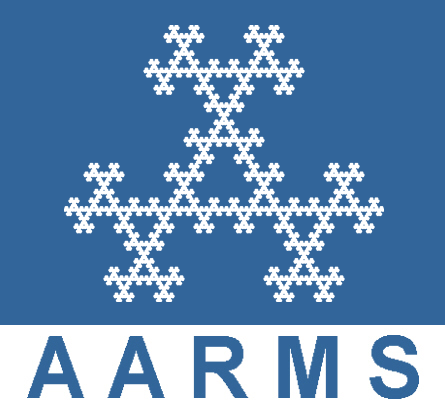Réunion d'hiver SMC 2016
Niagara Falls, 2 - 5 décembre 2016
- GUSTAVO CARRERO, Athabasca University
Describing and quantifying the binding pathway of histone H1 [PDF]
-
Histones H1 or linker histones are highly dynamic proteins that diffuse throughout the cell nucleus and interact with the chromatin structure (DNA and associated proteins), regulating its organization and DNA accessibility to transcription factors. The binding mechanism of histone H1 has been proven to involve a kinetic process characterized by rapid and slow binding interactions with the chromatin structure. When considering these two types of biding interactions explicitly in a mathematical model for the purpose of describing and quantifying the dynamics of histone H1 it becomes apparent that there could several binding pathways to the chromatin structure. In this work, we model all these different pathways using systems of reaction-diffusion equations and carry out a model comparison analysis using FRAP (Fluorescence Recovery After Photobleaching) experimental data from different histone H1 variants to determine the most feasible binding pathway of histone H1. The analysis favors two different types of binding pathways which share common features that provide new meaningful biological information on histone H1 dynamics. To illustrate the applicability of the results, we use the mathematical model describing one of the favored pathways to assess the kinetic changes of histone H1 after core histone acetylation.
- SAFOUHI HASSAN, University of Alberta
Numerical Treatment of Quantum Mechanical Problems [PDF]
-
The one dimensional anharmonic oscillator is of great interest to field theoreticians; it models complicated fields in one-dimensional space-time. The study of quantum anharmonic oscillators as potentials in the Schrödinger equation has been on the edge of thrilling and exciting research during the past three decades. Numerous approaches have been proposed to solve this problem and while several of them yield excellent results for specific cases, it would be favourable to have one general method that could handle efficiently and accurately any anharmonic potential.
The Sinc collocation method (SCM) has been used extensively to solve many problems in numerical analysis. Their applications include numerical integration, linear and non-linear ordinary differential equations. The double exponential transformation yields optimal accuracy for a given number of function evaluations when using the trapezoidal rule in numerical integration. Recently, combination of the SCM with the double exponential (DE) transformation has sparked great interest.
In this talk, we present a method based on the double exponential Sinc collocation method (DESCM) for solving anharmonic oscillator eigenvalue problems to unprecedented accuracies. The DESCM approximates the wave function as a series of weighted Sinc functions and by evaluating the expression at several collocation points, we obtain a generalized eigensystem which can be transformed into a regular eigenvalue problem. The method is successfully applied to Coulombic anharmonic oscillator potentials that describe the interaction between charged particles and consistently arises in physical applications. These applications include interactions in atomic, molecular and particle physics, and between nuclei in plasma.
- CHANGO KEEM, Seoul National University
Irreducibility and components rigid in moduli of the Hilbert scheme of smooth curves [PDF]
-
Denote by $\mathcal{H}_{d,g,r}$ the Hilbert scheme of smooth curves, which is the union of components whose general point corresponds to a smooth irreducible and non-degenerate curve of degree $d$ and genus $g$ in $\mathbb{P}^r$. A component of $\mathcal{H}_{d,g,r}$ is rigid in moduli if its image in the moduli space $\mathcal{M}_{g}$ of smooth curves of genus $g$ under the natural map $\pi:\mathcal{H}_{d,g,r} \dashrightarrow \mathcal{M}_{g}$ is a one point set. In this talk, we discuss about the non-existence of a component rigid in moduli for $g>0$ and $r=3$. In case $r \geq 4$, we also discuss about the non-existence of a component of $\mathcal{H}_{d,g,r}$ rigid in moduli in a certain restricted range of $d$, $g>0$ and $r\ge 4$. In the course of the discussion, we establish the irreducibility of $\mathcal{H}_{d,g,3}$ beyond the range which has been known before.
- MUHAMMAD SUFYAN, University of Punjab Gujranwala Campus
Mathematical Modeling of Transmission of Dynamics of HIV/AIDS and other viral disease [PDF]
-
Numerical Modeling comprises construction, application and analysis of
reliable numerical schemes to solve continuous models. These schemes are
constructed with the aim that discrete model displays the same behavior as the
continuous model. Discrete models must have some very important properties like
stability, dynamical consistency, positivity and boundedness of the solution. In this
dissertation , a dynamical model for the transmission dynamics of HIV/AIDS and a
dynamical model for the transmission dynamics of Dengue fever has been
constructed by introducing a new partition of SIR Model.Using
standard methods for analyzing a system, the stability of disease free equilibrium
point of this immunization based model has been determined. Finally an
unconditional numerical model has been constructed and analyzed for the same
problem and numerical experiments are performed for
different values of discretizations parameter “h”. Results are compared with well known
numerical scheme i.e. Euler’s and Runge-Kutta method of order four (RK-4),
Unlike Euler’s RK-4 which fails for large time steps, the developed numerical
scheme for the HIV/AIDS model gives results that converged to steady states of the
continuous model for any time step used.





